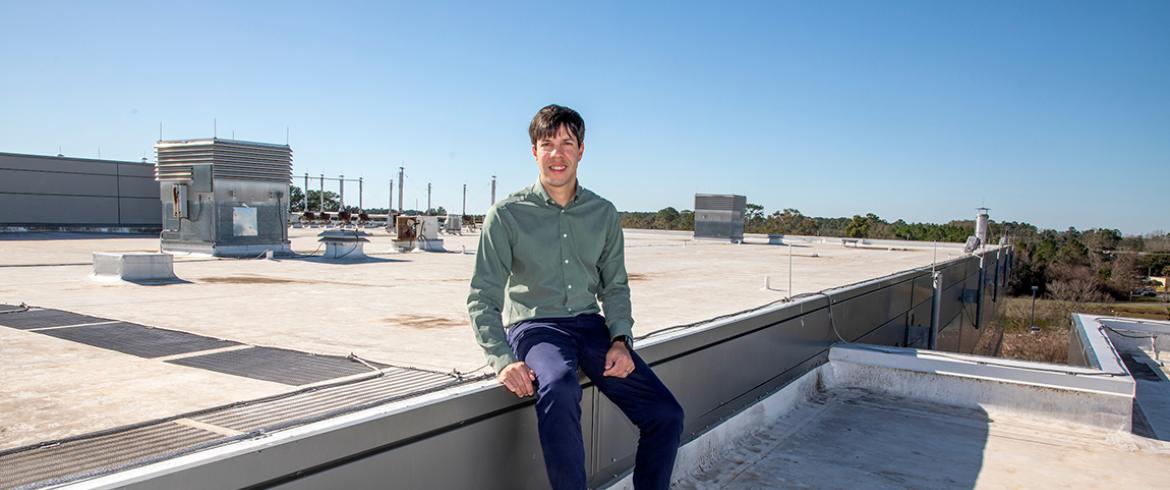
Assistant Professor Pedro Fernández-Cabán studies how structures can be designed for more disaster resiliency, an important topic in the Southeast. (Mark Wallheiser/FAMU-FSU College of Engineering)
Wind from a category 1 hurricane can reach nearly 100 mph, fast enough to damage homes and snap tree branches. Category 5 hurricane winds exceed 157 mph and can destroy buildings, leaving areas uninhabitable for weeks or months.
FAMU-FSU College of Engineering Assistant Professor Pedro Fernández-Cabán researches better methods for quantifying the intensity of hurricane winds and how those winds affect the structural integrity of buildings.
He explained the challenges of his research, how scientists are using artificial intelligence to understand better wind fields and how this work benefits the public:
What is the focus of your research?
My work integrates field experiments and wind tunnel modeling to understand extreme hurricane winds better and quantify their impact on civil infrastructure. Most of my focus is on buildings, which could be residential, or other types of low-rise or high-rise structures.
My group collaborates with multi-institutional research teams that go out to the field and try to capture what the wind field is doing at ground level. Then, we bring that knowledge to the lab and replicate it with scaled building models in the wind tunnel. For example, we characterize the wind pressure on the surface of a building. Our research is intended to influence future design standards and building codes used by civil and structural engineers.
What is the most common wind-induced damage that affects residential buildings?
Roof failure is a common wind-related damage in low-rise residential construction. These roof failures result from high suction forces on roof systems and usually develop near roof edges or corners. We see much of that damage in coastal communities, where wind speeds and hurricane wind fields are more intense.
Can engineers infer the intensity of hurricane winds based on damage to structures?
That is one of our challenges, especially for some of my colleagues involved in post-disaster or post-storm damage surveys. Hurricane-induced damage is not uniform. It’s location-dependent. We can see the structural damage, but we have difficulty recreating localized wind hazard conditions.
It’s hard to link the damage we see in structures to the wind field at the time of failure. That is a consequence of limited near-ground observations. During a hurricane, power often goes out and keeping weather stations functional is hard. Because of that, we have very little information about what the wind field is doing near the ground.
That is a challenge we are working on right now in our research: to better infer or predict the wind field's intensity, direction and turbulence, and then relate that to some of the observed damage we see.
Are some coastal communities more susceptible to wind-related damage than others?
One of the main parameters we consider when quantifying near-surface wind fields is terrain. If you're assessing a particular building, you would look at the upwind terrain, which will dictate how intense the wind will be or what turbulence the building may experience.
If you’re in a coastal community and you have upstream terrain that is relatively smooth with very few obstructions, you would expect higher wind speeds. For example, if you have communities that are very close to the shoreline, you’re in what we call marine exposure, where wind speeds are typically more intense. On the other hand, if you’re in more built-up suburban terrain, the obstruction from trees and other surrounding buildings tends to slow down the wind.
What are your field's biggest challenges and opportunities that could become more relevant in the next five to 10 years?
My research group and other colleagues within the wind engineering community are trying to integrate artificial intelligence and machine learning to help us understand what is happening with the near-surface wind field during hurricanes.
There are not many observations out there, but tools like machine learning can use that limited data to fill in the gaps in regions where we don’t have reliable observations or stations equipped with high-resolution instrumentation that would give us an idea of the intensity, direction, and turbulent properties of a wind field.
We also use terrain data from satellite images near the coastline and try to integrate machine learning algorithms to tell us the effect of that local terrain and topography on the wind field for a community that might be vulnerable to hurricane winds.
RELATED ARTICLES
Making Roofs More Hurricane-Proof Through Better Geometry
Civil Engineering Professor Awarded NSF Early CAREER Grant for Novel Wind Research
Engineering Faculty Expands by a More Than a Dozen for Fall 2022
